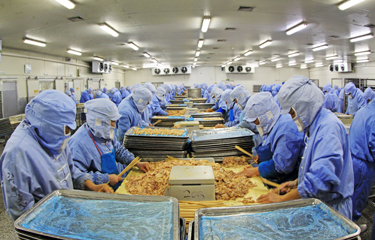Swelling demand intensifying challenges facing China’s seafood processors

Chinese processing factories are suffering “a lot” from rising costs related to heightened inspections and delays on seafood being shipped into China, according to a supplier of processing equipment to the industry.
Wang Yunfeng, the CEO and founder of Shanghai AUS Food Technology Co, which imports fish processing machines from Europe to China, said those costs are exacerbating troubles already faced by the industry, which is in the midst of a seismic shift from production for export to feeding domestic demand for seafood.
“Costs have increased. And what is more difficult is that all inspections of Chinese Customs have become very harsh and it takes [such a] long time and so many procedures to get imported raw material,” Wang said. “For my processing factory clients, it is not a problem to get foreign clients and orders. The problem is to get raw material for processing. After processing, when the Chinese factories want to export, troubles start again.”
In a possible lift for processors, China has temporarily cut the import tariff on whole frozen cod from 5 percent to 2 percent this year, with the rate on frozen cold-water shrimp and frozen salmon reduced from 7 to 5 percent effective from 1 January this year. Processors are nonetheless in a bind when it comes to balancing cost-cutting with investing for long-term productivity gains, Wang said.
“The factories want to save costs. Of course, they do not dare to invest right now [in] new equipment, but I can see their interest has grown,” Wang said. “They want to cut off the labor but they do not dare, either. Because once the market blooms again, it will be doubly difficult for them to find new workers who are willing to work in this industry. I can feel that they are pushing so hard to keep the minimum production and in this way, they can keep the workers for a longer time.”
‘Survival’ meanwhile is currently the watch word of the seafood processing industry, said Wang.
“As an importer of processing equipment, we are also trying hard to convince our potential clients. Machines are more reliable for future processing business," Wang said. "And my potential clients have known that. They just do not have the confidence and financial strength to invest yet.”
Making their decision more difficult, Chinese Customs continues to flag foreign seafood firms for shipments they identify as carrying traces of live COVID-19 into the country. On 9 April, Indonesian seafood exporter PT Sumberlautbengindo became the latest exporter to be been barred from the Chinese market for one week due under the General Administration of Customs Number 103 rule, introduced last year, after Customs claimed three batches of the company’s frozen squid and ribbonfish were identified as carrying COVID-19. Similar suspensions were handed down last week to two Russian exporters.
Chinese seafood imports last year were down 20 percent year-on-year, but from a high base set in 2019. There has been a large increase in seafood imports over the past decade – imports quadrupled between 2002 and 2019 – and this trend is unlikely to change, Wang said. But there may be a long-term impact for the international processing trade as processing factories switch focus to domestic customers, according to Wang.
“In order to survive, many of my clients have tried to do more with products for the domestic market, she said. “I have seen this trend for a long time back and now I can see that COVID-19 has accelerated the process. But it also takes time to increase the market-share, so their production capability has dropped a lot.”
There are increasing signs that domestic demand for seafood is strengthening in China. The country’s March inflation figures show that average seafood prices rose 8.1 percent during the month compared to the same period last year. By contrast, prices for pork dropped by 18 percent and poultry meat prices dropped 4 percent year-on-year, according to figures published by the National Statistics Bureau. Additionally, a report in early April by China Central TV’s finance channel suggested wholesale prices for crayfish in Wuhan, the capital of Hubei Province, a key crayfish region, are up by 40 percent compared to last year, suggesting a recovery in demand.
A Chinese meat and seafood importer, who asked to remain anonymous to protect business secrets, told SeafoodSource the firm plans to increase by tenfold the amount of chum salmon it's shipping from Russia to meet demand in northern China.
“We bought 54 tons of chum salmon last September from Russia,” the importer said. “When the salmon arrived in Tianjin port in October, the virus controls prevented the seafood containers from being moved out from storage.”
Having finally delivered the 54 tons in early March 2021, the importers’ clients now want more.
“The fish were really good quality [and] the demand has increased,” the importer said. Recently, his firm placed an order for 500 metric tons (MT) to be delivered in July, during the 2021 chum salmon season in Russia.
Photo courtesy of Yuangeng Zhang/Shutterstock






Share